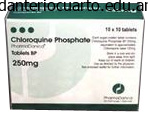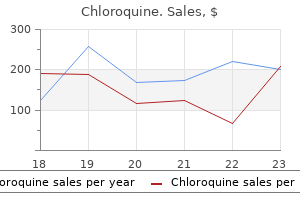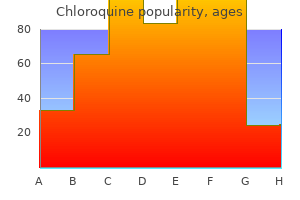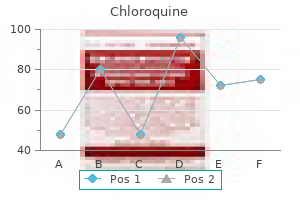

Amani M. Allen PhD, MPH

https://publichealth.berkeley.edu/people/amani-allen/
Chloroquine dosages: 250 mg
Chloroquine packs: 30 pills, 60 pills, 90 pills, 120 pills, 180 pills, 270 pills, 360 pills

In distinction, the core genome of the genus decreases with increasing genome numbers and at last reaches a plateau accounting for less than a fifth of the average gene content material (ca. It stays to be seen whether intensive aquaculture can account for the restructuring of its genome. This reflects the human environments of the group during which proteases have distinguished roles in colonization, dental plaque formation, utilization of salivary proteins, interfering with host defenses, or spreading via tissue. An additional function discovered in this group is the enrichment for N-acetyltransferases, some of that are responsible for resistance to aminoglycoside antibiotics to which the group is intrinsically resistant. For the second group, the Pyogenic group, most of the enriched phrases involve the carbohydrate metabolism, together with the phosphoenolpyruvate-dependent sugar phosphotransferase system. This once more is because of the wide host and environmental ranges inhabited by this group, as emphasised by the statement that these genes already arose in the department resulting in the phylogenetic group. As could probably be anticipated, additionally enriched in the Pyogenic group is the pathogenesis term, with S. Aside from the central matter of the foregoing considerations, the coccoid morphology of the genus Streptococcus contrasts with its molecular dynamics by presenting a "near-dead-end" state in its phylogeny (66, 67). Mapping prokaryotic cell shape onto the phylogenetic tree reveals spherical cells solely at the suggestions of the branches, neither returning to different shapes nor occurring at primordial branches but having a polyphyletic origin. Thus, the coccus has selective worth and deserves increased consideration in efforts directed at understanding this multifaceted genus. Investigations into the latter subject may also have to concentrate on the coordinated regulation of metabolism and virulence as implicated by the omnipresent three metabolite-responsive global CcpA, CodY, and Rex regulators that decide the connection between streptococci and their hosts (68). Such interactions might facilitate colonization, lead to molecular host mimicry, or intrude with numerous host defenses towards invasion. Subsequent cloning and sequence dedication of the corresponding genes in addition to evaluation of immunoreactivity afforded conclusive evidence in help of this notion (47, 70�76).
Identification and biochemical characterization of the ligand binding domain of the collagen adhesin from Staphylococcus aureus. Streptococcus pyogenes recruits collagen via surface-bound fibronectin: a novel colonization and immune evasion mechanism. Identification of a streptococcal octapeptide motif concerned in acute rheumatic fever. Expression profile, binding traits, organic functions, and potential medical impression. Structural mannequin for covalent adhesion of the Streptococcus pyogenes pilus via a thioester bond. A extremely uncommon thioester bond in a pilus adhesin is required for efficient host cell interplay. Autoimmunity and molecular mimicry in the pathogenesis of post-streptococcal heart disease. The SpeB virulence issue of Streptococcus pyogenes, a multifunctional secreted and cell floor molecule with strepadhesin, laminin-binding and cysteine protease activity. Novel laminin-binding protein of Streptococcus pyogenes, Lbp, is involved in adhesion to epithelial cells. Expression, purification, crystallization and preliminary crystallographic analysis of laminin-binding protein (Lmb) from Streptococcus agalactiae. Spellerberg B, Rozdzinski E, Martin S, WeberHeynemann J, Schnitzler N, L�tticken R, Podbielski A. Lmb, a protein with similarities to the LraI adhesin household, mediates attachment of Streptococcus agalactiae to human laminin. Al Safadi R, Amor S, Hery-Arnaud G, Spellerberg B, Lanotte P, Mereghetti L, Gannier F, Quentin R, Rosenau A. Shr is a broad-spectrum floor receptor that contributes to adherence and virulence in group A streptococcus. Protective immune response against Streptococcus pyogenes in mice after intranasal vaccination with the fibronectin-binding protein SfbI. Identification and characterization of a brand new protein from Streptococcus pyogenes having homology with fibronectin and fibrinogen binding proteins. Streptococcus pyogenes fibronectinbinding protein F2: expression profile, binding traits, and influence on eukaryotic cell interactions.

Peptidoglycan N-acetylglucosamine deacetylase, a putative virulence think about Streptococcus pneumoniae. Attenuation of penicillin resistance in a peptidoglycan O-acetyl transferase mutant of Streptococcus pneumoniae. Peptidoglycan O-acetylation is functionally related to cell wall biosynthesis and cell division in Streptococcus pneumoniae. From models to pathogens: how much have we discovered about Streptococcus pneumoniae cell division Functional analysis of Streptococcus pneumoniae MurM reveals the region responsible for its specificity in the synthesis of branched cell wall peptides. Mutational evaluation of the Streptococcus pneumoniae bimodular class A penicillin-binding proteins. Autolysis and cell wall degradation in a choline-independent strain of Streptococcus pneumoniae. Abnormal physiological properties and altered cell wall composition in Streptococcus pneumoniae grown within the presence of clavulanic acid. Structure of the pneumococcal l,D-carboxypeptidase DacB and pathophysiological results of disabled cell wall hydrolases DacA and DacB. Sortase, a universal goal for therapeutic agents in opposition to Gram-positive micro organism Molecular characterization of the pneumococcal teichoic acid phosphorylcholine esterase. Penicillin-binding proteins of multiply antibiotic-resistant South African strains of Streptococcus pneumoniae. A organic price of antibiotic resistance: main adjustments in the peptidoglycan construction of penicillin-resistant pneumococci. Distribution of the mosaic structured murM genes among natural populations of Streptococcus pneumoniae. Non-penicillin-binding protein mediated high-level penicillin and cephalosporin resistance in a Hungarian clone of Streptococcus pneumoniae.

From one of the first descriptions of enterococcal an infection in 1899 (3) to the understanding of the function of virulence factors in illness and identification of novel antimicrobials, animal fashions have confirmed to be extraordinarily necessary within the examine of enterococcal pathogenesis, and their additional improvement will proceed to provide perception into diseases caused by enterococci. This intrinsic ruggedness undoubtedly plays a job in offering alternatives for enterococci to work together with different overtly drug-resistant microbes and purchase additional resistances on cell elements. The fast rise of antimicrobial resistance amongst hospital-adapted enterococci has rendered hospital-acquired infections a quantity one therapeutic challenge. Vertebrates Several infection fashions have been established in small mammals for a lot of of crucial enterococcal ailments. The introduction of a international body permits for initial adherence of enterococcal cells, leading to a robust infection of the cardiac tissue. Antimicrobialresistant pathogens related to healthcare-associated infections: abstract of data reported to the National Healthcare Safety Network at the Centers for Disease Control and Prevention, 2011-2014. Characterization of Enterococcus hirae outbreaks in broiler flocks demonstrating increased mortality due to septicemia and endocarditis and/or altered manufacturing parameters. Comprehensive report of an Enterococcus cecorum an infection in a broiler flock in Northern Germany. Intestinal domination and the chance of bacteremia in patients present process allogeneic hematopoietic stem cell transplantation. Nucleotide sequence analysis of the gene specifying the bifunctional 6-aminoglycoside acetyltransferase 2-aminoglycoside phosphotransferase enzyme in Streptococcus faecalis and identification and cloning of gene regions specifying the two actions. Mobile genetic parts and their contribution to the emergence of antimicrobial resistant Enterococcus faecalis and Enterococcus faecium. Antimicrobial treatment of infective endocarditis because of viridans streptococci, enterococci, and staphylococci. Bactericidal exercise of vancomycin, daptomycin, ampicillin and aminoglycosides against vancomycin-resistant Enterococcus faecium. Survival of Enterococcus faecalis in an oligotrophic microcosm: modifications in morphology, development of general stress resistance, and evaluation of protein synthesis.

These approaches are also leading to new perception concerning potential treatments of certain cancers, including these described in the chapter introduction. This article presents a common dialogue of the current biological view of most cancers, describing selected examples of the role gene mutations and chromosome mutations play in cancer improvement, outlining cancer cell genome sequencing methods, and surveying new drug-based and immune system�based approaches to most cancers therapy. Rather than being a single disease, most cancers is a category comprising many illnesses that differ by the gene mutations liable for their origin and the cell types during which they happen. Even cancers affecting the same tissue in numerous individuals may have totally different mutations. These differences are manifested in dissimilarities in most cancers growth rates, degrees of invasiveness, ages of onset, responsiveness to remedy, and prognosis. Nevertheless, all most cancers cells can be described as differing from normal cells in four basic methods. This signifies that in comparison with normal somatic cells from the same tissue, most cancers cells look completely different and behave differently-more like primordial cells than specialized cells. Second, in contrast with regular cells, most cancers cells have a better rate of proliferation. In other phrases they divide and grow rather more rapidly than normal cells of the same tissue. Third, cancer cells are bigger than their normal counterparts and also have bigger nuclei. Whereas normal cell progress is confined to the boundaries of each kind of tissue and restricted by cell-to-cell contact, most cancers cells not only lose their cell-to-cell sensitivity however have the propensity to overgrow their normal confines and invade surrounding tissues. Like those cancers, the remaining 5 to 10% require the presence of multiple mutations, however in this smaller group, one or more of the mutations is inherited, making the pathway Progression of Abnormalities Cancer cell lineages evolve via mutations from normal cells. Abnormal tissue development generally follows a pattern of accelerating, however noncancerous, abnormality beginning with hyperplasia that can progress to dysplasia. Neoplasia (cancer) can follow, and metastasis can happen if neoplastic development invades normal tissue. The abnormality can first appear as hyperplasia, which means further growth, and progress to dysplasia, meaning disorganized growth. For instance, irregular growths on the skin could be eliminated rapidly and just by spraying the expansion with liquid nitrogen (-321 F, or -196 C) to kill the abnormal cells by freezing.

The regulatory function in cell wall biosynthesis of its paralog, GpsB, seems to turn out to be more clear. GpsB depletion resulted in elongated cells with a quantity of Z-rings, however no helical localization of FtsZ in twisted-towels cells was observed. However, D39 cells depleted for GpsB showed decreased StkP-mediated phosphorylation that might be suppressed by useful inactivation (mutation or deletion) of its cognate PhpP phosphatase, which also relieved the cells from the need of GpsB. A comparable suppressor mutation inactivating PhpP was detected in DgpsB mutants obtained in the other, commonly used, D39 laboratory derivative, Rx1 (122). The current studies of GpsB (120, 122) each agreed that inactivation of GpsB reduces StkP-mediated phosphorylation and, consequently, that GpsB is necessary for optimum phosphorylation. Division Site Selection (MapZ/LocZ) and Origin of Replication Until lately, no mechanisms for focusing on FtsZ and the division advanced to the nascent septum were recognized, and no counterparts of the widespread or specific techniques described in different micro organism, had been found to be present in S. Rod-shaped model species use the Min system and nucleoid occlusion to stop asymmetric cell division and/or forestall the septum from constricting over unsegregated chromosomes, however in distinction to the striking conservation of the proteins that constitute the cell elongation and division complexes, the proteins involved are poorly conserved (reviewed in 158�160). The protein was named MapZ (for midcell-anchored protein Z) (145) or LocZ (for localizing at the midcell of Z) (146) and was proven to be a membrane protein consisting of a cytoplasmic area and two extracellular domains separated by a extremely entropic serine-rich region. MapZ/LocZ has a somewhat narrow phylogenetic distribution, being current only in streptococci, enterococci, and lactococci. Consistent with its proposed operate, MapZ/LocZ was discovered to localize as a hoop at midcell at the very early phases of cell division and earlier than FtsZ (145) or FtsZ/FtsA (146). After the equatorial rings of recent daughter cells assemble into septal rings, MapZ/LocZ splits into two rings that move away with the so-called wall bands or equatorial rings till they attain the equators of the newly forming daughter cells, marking the longer term division sites (145, 146). The gene encoding MapZ/LocZ was found to be dispensable in four genetic backgrounds, R800 (145), D39, R6, and Rx1 (146), and its deletion resulted in misshapen cells usually exhibiting misplaced septa (145, 146). A direct interaction between the MapZ cytoplasmic domain and FtsZ was detected, and MapZ alleles missing the N-terminal domain had been unable to promote correct FtsZ placement (145). Finally, each research recognized that MapZ/LocZ was phosphorylated by StkP at Thr67 and Thr78 and that each phosphomimetic (T67-78E) and phosphoablative (T67-78A) allelic variants localized to midcell, though the phenotypes of the strains differed fully, ranging from extreme defects in cell shape and viability with aberrant FtsZ constructions and reduced numbers of Z-ring per cell (145) to no evident morphological defects and a wild-type morphology (146). While these points have to be clarified, additional evaluation of MapZ, using each a genetic and a structural strategy, demonstrated the importance of the second extracellular area, which reveals a marked flexibility at acid pH, while demonstrating that the primary extracellular area is likely a molecular scaffold or pedestal, required to mark the division web site (161). In specific, the position of the chromosome origin of replication precedes MapZ/LocZ at midcell and promotes using the correct division website (162). The localization profile of MapZ/LocZ in the course of the cell cycle was in maintaining with previous reviews; nonetheless, two and not three MapZ-rings had been noticed, consistent with what was beforehand noticed for S.
Diseases
An additional reason that mutation alone is a gradual evolutionary course of has to do with the 2 instructions in which mutation can have an result on any given allele. Forward and reverse mutation can create a balanced equilibrium, given a enough number of generations and the absence of other evolutionary processes. Quantifying the Effects of Mutation on Allele Frequencies In the absence of other evolutionary effects, the consequences of ahead and reverse mutation (reversion) for allele frequencies in a inhabitants can be quantified. If f (A1) = p and f (A2) = q, the impact of ahead mutation on f (A1) is described by the worth mp, and the effect of reversion on f (A2) = nq. These two expressions establish, respectively, the speed at which A2 alleles are created from A1 by forward mutation and the speed at which A2 alleles are reverted to A1. Over an infinite variety of generations in a theoretical inhabitants where m and n are fixed and no other evolutionary processes are working, allele frequency equilibrium is established. The equilibrium frequencies of alleles subject only to mutation and reversion are a ratio of the frequencies of the respective events. This small change gradually increases f (A2) and reduces f (A1), main finally to equilibrium allele frequencies. When equilibrium is achieved by the interaction of forward and reverse mutation rates on this inhabitants, the allele frequencies might be pE = three * 10-8/(2 * 10-6 + 3 * 10-8) = 0. This ends in the persistence of recessive mutant alleles in most populations at a frequency somewhat greater than the mutation frequency. Under these circumstances, the frequency of mutant alleles in a population is a steadiness of the depth of natural selection against the mutant and the frequency of mutation of the gene. This expression known as the mutation�selection balance, and it determines the equilibrium frequency of the mutant allele (qE) by considering the rate of elimination of deleterious alleles by pure selection (s) and the speed at which new mutant alleles are generated (m). Genotype Relative fitness A1 A1 1 A1 A2 1 A2 A2 1 - s Here, the equilibrium frequency of the recessive allele (qE) is calculated because the balance between selection in opposition to a recessive genotype (s) and the rate of mutation (m): this expression predicts that when selection towards the recessive genotype is complete. In the case of full selection in opposition to a lethal dominant mutant allele B2, the relative fitness values of the genotypes are as follows. Genotype Relative health B1 B1 1 B1 B2 1 - s B2 B2 1 - s qE = 2m /s In this case, qE = m. Numerous examples of mutation�selection stability have been investigated in organisms, including humans. Several research of human hereditary illness alleles reveal that recessive mutant alleles are maintained in populations at frequencies predicted by calculating the mutation�selection balance.

Plasmin(ogen) acquisition by group A Streptococcus protects in opposition to C3b-mediated neutrophil killing. Streptococcus pyogenes escapes killing from extracellular histones through plasminogen binding and activation by streptokinase. Streptococcus pyogenes triggers activation of the human contact system by streptokinase. The organism has the flexibility to spread quickly via tissue and to penetrate into the vasculature to trigger deadly sepsis. Other illnesses outcome from the manufacturing of poisons that unfold via tissue or spread systemically from a site of local an infection (scarlet fever and poisonous shock syndrome). These diseases include rheumatic fever, acute glomerulonephritis, sure kinds of psoriasis, and probably even some forms of obsessive-compulsive syndrome disorder (pediatric autoimmune neuropsychiatric disorders related to streptococcal infections). This is simply a partial list of the potential virulence factors this bacterium can produce, and many of these are considered in additional detail elsewhere. Until just lately, the function that any of these potential virulence elements contributed to the pathogenesis of any particular streptococcal illness was solely poorly understood. A major cause for this deficiency was the lack of subtle genetic systems that could be utilized to the analysis of a specific virulence factor according to modern molecular standards. These state that (i) the phenotype beneath investigation must be related to pathogenic members of a species, (ii) the gene(s) associated with the virulence trait ought to be recognized and isolated by molecular methods, (iii) particular inactivation of identified gene(s) ought to lead to a measurable loss in pathogenicity, and (iv) reintroduction of the unmodified wild-type gene should result in a restoration of pathogenicity. An exciting growth is that, over the past several a long time, the work of many groups has contributed to the development of sophisticated group A streptococcal genetic techniques that now enable the many ailments that this organism could cause to be studied at this stage of molecular resolution. The other main advance has been in the growth of a variety of genetic instruments geared toward manipulating the S. The aim of this article is to current an outline of those tools, including the strategies of genetic modification and their applications.

Nucleotide sequence evaluation of genes essential for capsular polysaccharide biosynthesis in Streptococcus pneumoniae sort 19F. Characterization of the locus encoding the Streptococcus pneumoniae kind 19F capsular polysaccharide biosynthetic pathway. Molecular and genetic characterization of the capsule biosynthesis locus of Streptococcus pneumoniae type 19B. Functional analysis of glycosyltransferases encoded by the capsular polysaccharide biosynthesis locus of Streptococcus pneumoniae serotype 14. Capsular polysaccharide synthesis in Streptococcus pneumoniae serotype 14: molecular analysis of the complete cps locus and identification of genes encoding glycosyltransferases required for the biosynthesis of the tetrasaccharide subunit. Molecular construction of the gene cluster responsible for the synthesis of the polysaccharide capsule of Streptococcus pneumoniae kind 33F. Molecular characterization of the complete 23F capsular polysaccharide locus of Streptococcus pneumoniae. Analysis of the 5 portion of the type 19A capsule locus identifies two lessons of cpsC, cpsD, and cpsE genes in Streptococcus pneumoniae. Comparative genetics of capsular polysaccharide biosynthesis in Streptococcus pneumoniae sorts belonging to serogroup 19. Molecular and genetic characterization of the capsule biosynthesis locus of Streptococcus pneumoniae kind 23F. A single gene (tts) positioned outside the cap locus directs the formation of Streptococcus pneumoniae sort 37 capsular polysaccharide. Molecular characterization of Streptococcus pneumoniae kind four, 6B, eight, and 18C capsular polysaccharide gene clusters. Organization and characterization of the capsule biosynthesis locus of Streptococcus pneumoniae serotype 9V. Genetic foundation for the structural distinction between Streptococcus pneumoniae serotype 15B and 15C capsular polysaccharides. Genetic analysis of the capsular biosynthetic locus from all 90 pneumococcal serotypes. Cloning and sequencing of a gene involved in the synthesis of the capsular polysaccharide of Streptococcus pneumoniae type three.
IgA binding is obvious solely in emm clusters E1, E4, and E6 products, whereas fibrinogen binding is restricted to M proteins of clade Y, and plasminogen binding is restricted emm cluster D4 (51, 65). Additional investigation of the structure and practical binding properties of the M-like proteins, and construction of the mrp and 12. However, sof typing is much less developed than emm typing, and attempts to generate a well-supported phylogeny for the sof type-specific determinants have largely failed due to extensive intragenic recombination (81). The relationships between T-typing sera and recombinant pilin proteins has been examined (48, 92, 97). For pilus structural protein genes: bp, tee, and fctA, spine pilins; ap1, ap2, fctX, cpa, and fctB, ancillary pilins. Fibronectin-binding protein genes embody prtF1 (sometimes designated sfbI), prtF2 (sometimes designated pfbp), and probably others that stay to be categorised. Possible unmasking of immunological determinants through the trypsin pretreatment used in the cell agglutination assay might additional complicate efforts to draw direct connections between T-serotypes and specific pilin protein variant forms. In this skewed, non-population-based pattern, the dominant T sorts amongst emm sample A-C strains are T1, T11 and/or T12, and T3, T13, and/or B3264, reflecting the highly prevalent M/ emm sorts M1, M12, and M3, respectively. The most frequent M/emm sorts among pattern E isolates of this assortment are M4 and M28 (83), which largely reflects the dominance of the T4 and/or T28 serotype grouping (Table 5). Within an emm cluster group, there can be a very wide array of T types (based on Table 5; detailed information not shown) (83). Although emm genes within a cluster are more intently related to every another than to emm of different clusters, the extent to which floor pili contribute to the general antigenic cell surface repertoire seems to vary extensively by cluster. Shortcomings of the T-typing cell agglutination assay embody a basic lack of excellent resolution, the time-consuming process, and the requirement for standardized rabbit serum. In nearly all studies, core genome sequences are in contrast for isolates sharing the same emm kind, and quite a few key insights on genetic changes that underlie enhanced transmission and/or virulence have been uncovered. The core genome knowledge can be used to build evolutionary models of outbreaks and epidemics (see "Epidemiology: Building Evolutionary Models" and "Evolution: Short-Term" below). For large-scale strain surveillance, the flexibility to get hold of detailed information on typing and resistance features inside a single output, from a single uncooked knowledge input supply, has largely precluded the necessity for a number of typing protocols and antibiotic susceptibility testing. Among numerous different genes, antimicrobial resistance determinants are also assessed.
Sivert, 57 years: In many eukaryotes, this interplay between the opposing actions of writers and erasers entails a protein advanced known as the Polycomb group (PcG) appearing in gene repression and one other protein advanced called Trithorax (Trx) performing to preserve gene expression. Selection for met + was carried out on minimal medium containing glucose and phenylalanine. Preterm delivery associated with group B Streptococcus maternal colonization worldwide: systematic review and meta-analyses. Individuals homozygous or heterozygous for the mutant allele can then be recognized in the acceptable M2 household.
Derek, 47 years: In other words, heritability is excessive when a lot of the phenotypic variation is produced by genetic variation and little is contributed by environmental variation. To date, however, the relationship between integrin-generated alerts, formation of focal adhesion complex, and Rac and Cdc42 is poorly understood and is unsupported experimentally. Epidemiologic research of Streptococcus pneumoniae in infants: acquisition, carriage, and an infection in the course of the first 24 months of life. Instead, the duplex retains its double-stranded form, inflicting translation to be blocked.
References
Realice búsquedas en nuestra base de datos: